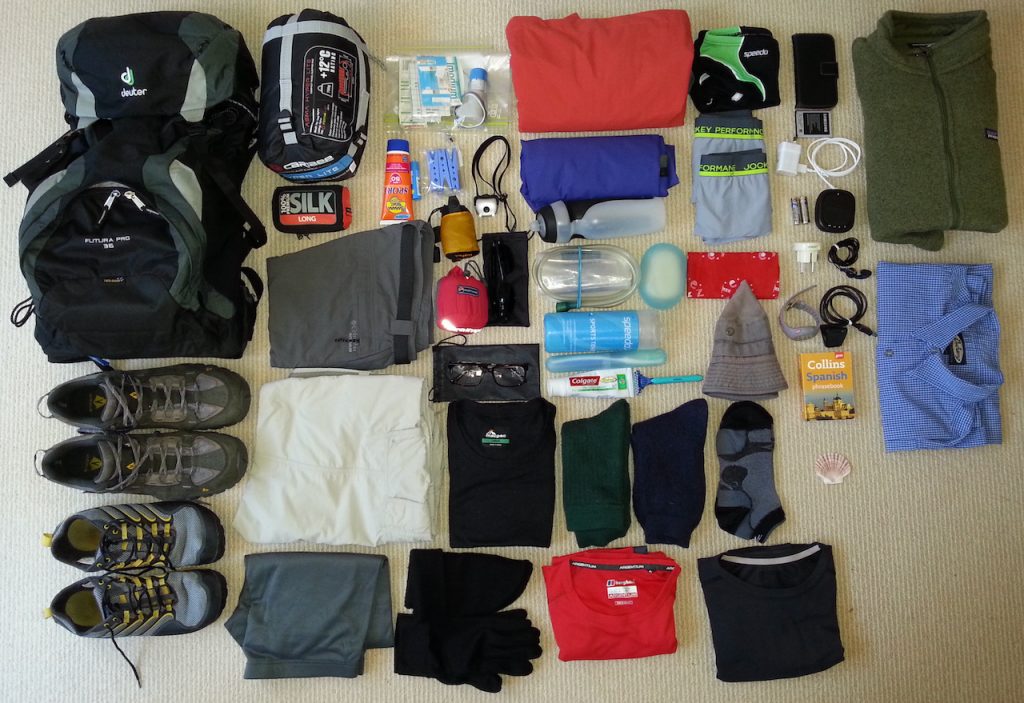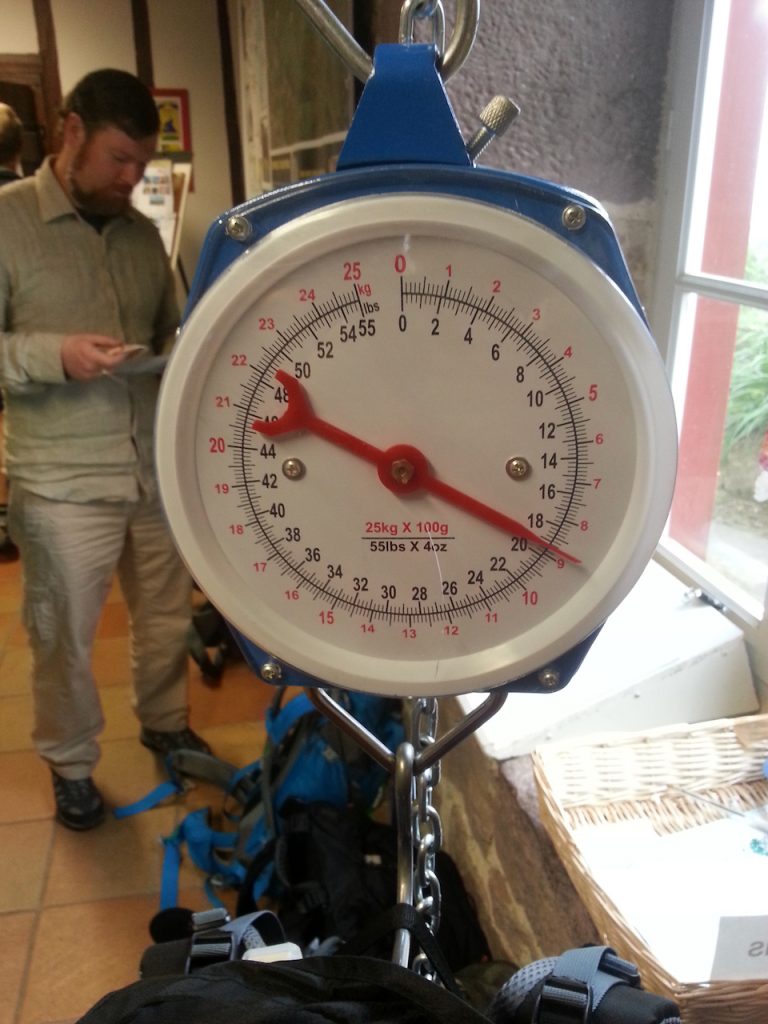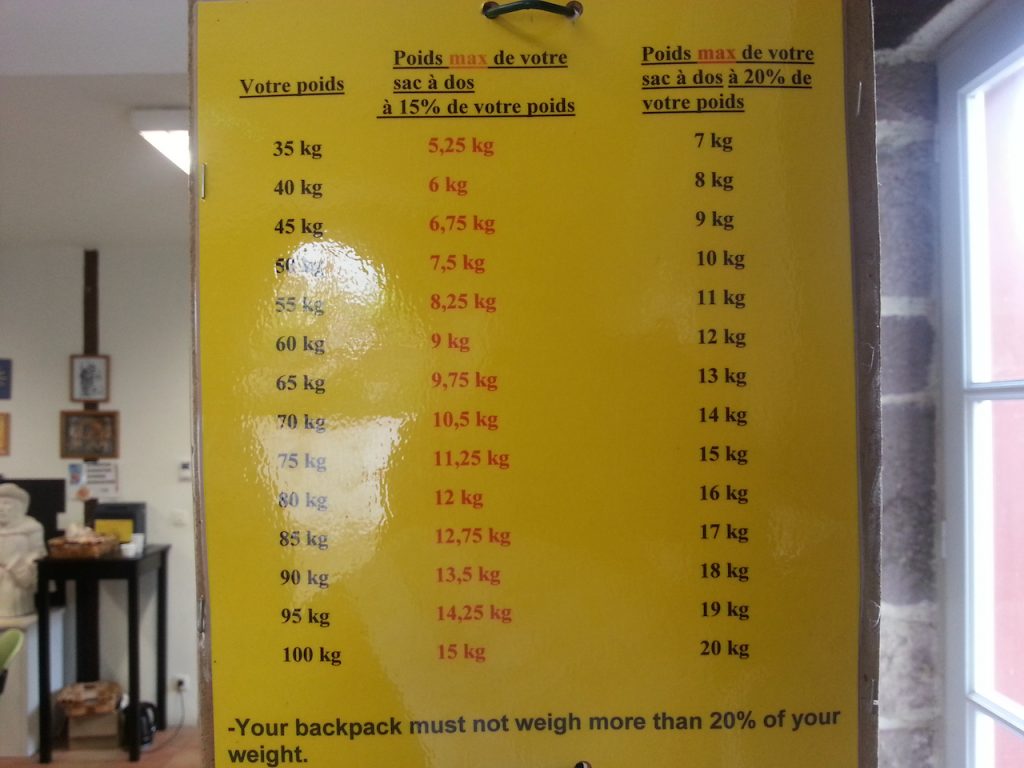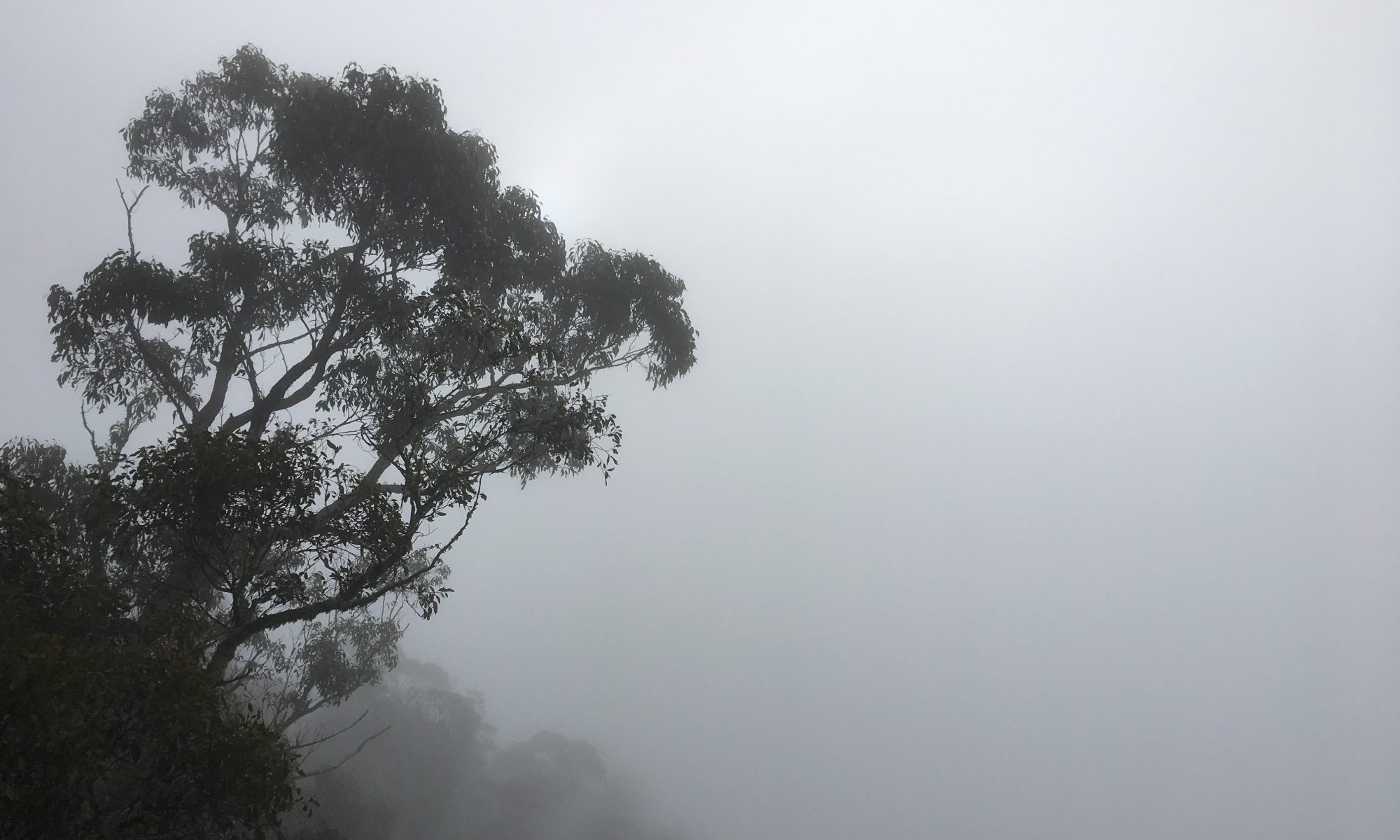What I took …

The loaded pack weighed around 8 kg, not including water and food (see photo below). I expected cool and sometimes wet weather in May (“12-20 C, with heavy rain, but sometimes with nice sunny days“) hence took more warm base layers and heavier-duty rainwear than I would otherwise carry if I walked in the height of summer. In June I expected warmer and drier conditions (“ideal weather for walking, not too hot (20-30 C) and occasional light rain“).
| Carrying the load | Post-Camino notes |
| Hiking pack Deuter Futura Pro 36 (36 L) |
I really liked this pack. It was just the right size for the gear I took and was very comfortable to wear. (It’s not waterproof, but it comes with a waterproof raincover.) The frame and harness system, which includes a mesh back pad, creates a ventilation space between bag and back, which meant my shirts didn’t get soaked with sweat. The pack also has a separate externally accessible compartment at the bottom that was big enough to hold my sleeping bag and liner and let me access those items without having to unpack the entire pack. The pack is within size limits for airline cabin baggage, too (although it can easily be loaded with more than the weight permitted by some fare types). |
| Day pack Sea to Summit Ultra-Sil |
Very handy for carrying personal items when wandering around at the end of a day’s walk and on rest days. Weighs next to nothing and folds into a small stuff sack. |
| Sleeping | |
| Sleeping bag Caribee Plasma Hyper Lite |
A lightweight (0.7 kg) indoor bag. Used less than I expected as the rooms in the albergues, refuges, etc. warmed up very quickly at night once everybody was in bed (in fact most rooms tended to get very stuffy very quickly even when windows were open). Mostly I slept on the sleeping bag, in the liner (see below). |
| Sleeping bag liner Sea to Summit 100% Premium Silk |
I slept in this every night, mostly on the sleeping bag instead of in it (see above). |
| Technology | |
| Mobile phone + charger, spare battery | Phone used daily for taking photos and, via wifi, for updating this blog, email, checking the weather forecast (from yr.no), and for Viber and WhatsApp conversations with family back home. I had an international travel SIM (from Australia Post) for phone calls and texting over the local mobile networks. |
| Satellite tracker + spare batteries SPOT Connect |
Used daily, attached to an external loop on the top of my pack. Automatically logged my GPS location every 10 minutes to a Google map on a dedicated web page so that family and friends could track my progress. (The map on the Route page reflects data from the SPOT.) Powered by two AA lithium batteries, which were good for around seven days walking. (Availability of replacement batteries was limited along the Camino; I found some old stock in a camera store in one of the plazas in Burgos – they lasted a few days only, then chanced on some fresh stock in a shop for pilgrims in Carrión de los Condes.) Also has a limited text message function that I used to send my partner a check-in / OK message at the end of each day’s walk. |
| GPS watch + charger cable Garmin Forerunner 110 |
Used daily for recording walk data and route (as per the map links in the blog posts). A full charge was sufficient for a typical day’s walk (the owner’s manual suggests ‘up to eight hours’), with the low-battery warning displayed around the six-hour mark. The reset function / button failed part way through the Camino, but I discovered the device resets itself automatically when connected to a power source for charging. |
| Plug adapter for 2-pin Type C Europlug | Used daily for charging my phone. Inadvertently left behind when I departed the albergue at O Pedrouzo half awake and in the half light of dawn on the final day of the Camino. Replacement bought from Carrefour at Santiago de Compostela. |
| Ear phones Sennheiser MX 365 |
Used occasionally. |
| Footwear | |
| Hiking shoes Vasque Men’s Mantra 2.0 GTX |
I was really happy with these shoes. They were exactly the right size (I bought them from Amazon in the US as the wide-fitting version I wanted wasn’t available in Australia); they were extremely comfortable to wear with thick hiking socks (no blisters from the shoes over the entire Camino); they kept my feet dry in the rain and on the wet and muddy tracks of Galicia (they have a Gore-Tex membrane); and the heavy-duty Vibram soles provided good protection from the stony Camino paths. |
| Casual shoes Merrell Trail Glove |
Lightweight (0.4 kg) and easy to pack and carry. |
| Hydration | |
| Bladder Platypus 2 L |
Most days I carried a 1.5 L PET bottle for water – I generally drank around 3 L per day – because it was easier to use and refill than the in-pack bladder. I did use the bladder on a couple of days though when I wanted to keep my hands free while walking (e.g. for the climb from Vega de Valcarce to O Cebreiro), but it leaked each time when I inadvertently put the pack down on the loose bite valve (the second time all over the floor under my bunk in an albergue, which endeared me no end to the owner). |
| Water bottle | I started off carrying this standard 600 mL bottle, but unwittingly left it behind at a rest stop early in the Camino. I then bought a 1.5 L bottle of water to replace it and used that container from then on (see above). |
| Personal care | |
| Sports towel Speedo |
Used daily. Small, doesn’t weigh much (0.2 kg), dries you when it’s wet, doesn’t need to be dried before storing and packs easily in its plastic container. |
| Toothbrush + container, toothpaste | Used daily. |
| Soap + container | Used daily. |
| Sunscreen + lip balm | Used occasionally. |
| Disposable shavers (x 2) | Used daily. |
| Safety | |
| First aid kit | Used occasionally. Contained Panadol (paracetamol) tablets, Compeed blister patches, Imodium caplets, Fixomull tape (great for taping toes and feet, preventing blisters), Fisiocrem (for muscle pain) and an asthma inhaler. |
| Clothing – base layer | |
| Thermal top, s/sleeve | Not used. |
| Thermal long johns | Not used. |
| Thermal gloves | Used occasionally. |
| Technical crew-neck top, l/sleeve | Used frequently, for casual wear after finishing a day’s walk. |
| Technical crew-neck top, s/sleeve | Used daily (and washed daily too!). |
| Beanie | Used occasionally. |
| Clothing – mid layer | |
| Fleece jacket | Used frequently. |
| Clothing – light-wind layer | |
| Windproof jacket Montane Featherlite |
Used frequently, often early on foggy and damp mornings, over the fleece jacket. |
| Clothing – outer shell | |
| Rain coat Macpac Copland |
Used frequently in Galicia, but only occasionally prior to then (in La Rioja mostly). |
| Overtrousers | Not used. |
| Clothing – other | |
| Ankle socks (1 pr) | Used frequently, with casual shoes. |
| Bandanna | Used daily. Prevented sunburn on the back of the neck. |
| Bathers | Used once (at a new albergue in Acebo that had a swimming pool). |
| Casual shirt | Used occasionally. |
| Hiking shorts | Used daily. |
| Hiking socks (woollen, 2 pr) | Used daily. Wore out one pair. |
| Reading glasses + soft case | Used daily. |
| Sunglasses + soft case | Used frequently. |
| Sunhat | Used frequently. |
| Travel pants | Used occasionally. |
| Underpants (2 pr) | Used daily (and washed daily too!). |
| Miscellaneous | |
| Trekking poles Leki Eagle |
Used occasionally. (Not shown in photograph.) I’m not a fan of trekking poles, but I bought these in León (from K2 Planet) as I’d strained badly the muscles / tendons at the top of my left leg on the way into León and thought the poles might help ease the load on them once I started walking again after a few non-walking recovery days. I ended up only using one pole, on steep and rough downhill sections of track (of which there were a few in Galicia) as the leg was least able to cope with descents for the first week or so out of León (it was okay on the flat and on most uphill sections). |
| Spanish phrase book | Used frequently. |
| Head lamp | Used once. |
| Pen | Used daily. |
| Journal | Used daily. (Not shown in photograph.) |
| Clothes pegs (x 6) | Used occasionally. |
| And with hindsight … | |
| Flip-flops | I thought about taking flip-flops for use in the showers in the refuges, but decided against doing so because I wanted to keep the weight of my pack down. I didn’t pick up any foot infections as it turned out, but with hindsight I would have felt more comfortable and it would have been prudent risk management to have worn flip-flops while showering, like many other pilgrims. |
There’s a spring scale for weighing packs in the pilgrims information centre in Saint-Jean-Pied-de-Port. Mine topped out at 8.75 kg on the morning of departure (a little more than I expected – a novel plus a substantial lunch bumped up the weight).

There’s also a table of suggested maximum pack weights in the information centre. I ended up with a pack weighing around 10% of my body weight.

